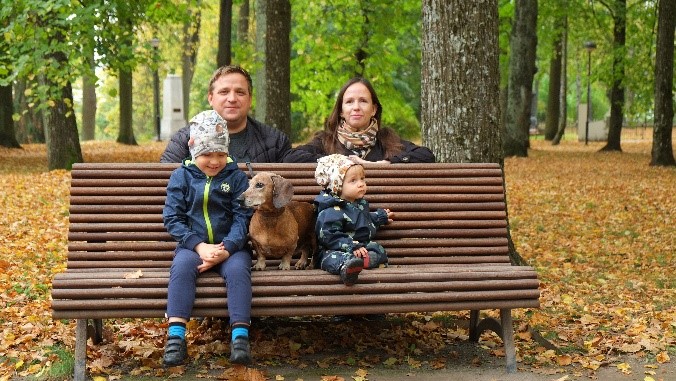
30 Nov Joy, guilt and research: the lives of mothers in science
Kairi Kreegipuu, Professor of Experimental Psychology at the University of Tartu, has been involved with science for almost 20 years. Today, she leads a research group made up entirely of mothers. Together, they have developed creative tactics for balancing family life and leadership in demanding academic work.
The main reason that has kept Kreegipuu in the field is the opportunity to solve questions creatively and the variety that comes with experimental psychology. “Sometimes I am embarrassed because I am able to do such cool stuff for a living. There are so many of those who cannot do as awesome a job as I do”, she says.
She defines experimental psychology as a method which involves doing experiments in order to explain causes of behavior and cognition. For example, she has explored how a heated environment and physical activity affect people’s mental capacity for work.
Kreegipuu has had an excellent career. Just a few months ago, after having worked as associate professor, she became full professor, which is the highest rank in the hierarchy of university academics.
According to the University of Tartu statistics, last year only one fourth of all professors were women (48 vs.138). However, the trend is changing, albeit slowly.According to Kreegipuu, in order to make it to becoming a professor, a person needs to be willing to contribute a lot, take responsibility for projects and employees and be ready to respond to surprises, which most of the time happen at the most unsuitable times. “And deal with the guilt that you feel from time to time. Either about the undone work or from where you pinched that work time”, describes Kreegipuu. Such fastidiousness occurs a lot on the higher academic level. To Kreegipuu’s mind, for people who have succeeded academically, it’s a part of their lifestyle. “It’s like a piece that belongs to their lives”, says the professor.
Kreegipuu adds that the best time for her to work is between the hours of 10 PM – 2 AM in the morning. It’s a system that she has created so between 6 PM -10 PM she can be dedicated to her family and ‘doing nothing’ (meaning workwise). “Nights when I sleep 3-5 hours occur every week”, says Kreegipuu. She doesn’t find it odd. Quite the opposite, she sees it as a gift given to her by nature as it isn’t as exhausting for her as it might be for some of her colleagues.
Kreegipuu’s colleague and research fellow in her latest project, Liisi Kööts-Ausmees noted that for her it sometimes feels like Kairi has more hours per day than everyone else. Kööts-Ausmees says that this is only because Kreegipuu doesn’t waste any time on worrying how some things might be complicated or impossible to achieve. Instead, she gets straight into the subject and if needed, finds the people who have the know-how to make it happen.
“Working alone doesn’t get you anywhere”, says Kreegipuu. Therefore, she emphasises that in order to succeed, it is vital to have a team. And not just any team – it needs to be a creative one as it helps to get input from their ‘fresh’ ideas. In addition, in the field of psychology there is always a risk of interpreting the findings according to one’s own experiences. Therefore, it is also important to have more than just one person in the project, to have various viewpoints when interpreting the data.
The project Kreegipuu is currently leading has that ideal team described above. However, what makes the team even more outstanding is the fact that all of the senior members are mothers. Moreover, 3 of the research fellows have a 1-year-old or a younger child. In Estonia, mothers are entitled to 1.5 years paid parental leave, whereas their job is preserved for 3 years. In the academic world, rules are there to be broken. Kreegipuu’s research fellow Kööts-Ausmees, whose youngest child is one year old, notes that if a scientist wants to keep moving forward in her career, pausing work for such a long period is not an option. Kööts-Ausmees gives an example, “I cannot ask my colleague to wait for 2 years while I am at home with a child and then come back and give the answer she needed.”

However, there are ways to get the best of both worlds. What Kreegipuu herself did was arrange the work in a way that she could continue working with a reduced workload. However, she also has a suggestion. In her opinion, an opportunity for both parents to have the option to be on parental leave together, could be of huge help. In that way, there could be more flexibility to divide the running of errands and this would create an opportunity to continue working part-time. Despite the fact that it isn’t regulated by law, Kreegipuu and her husband still divided responsibilities rather equally. She finds that thanks to the ‘untraditional’ family model, her children have had the opportunity to spend more time with their father than they would have if she had been the stay-at-home mom.
Kreegipuu’s second research fellow Nele Põldver – mother of a 1-year-old and a 4-year-old – also admits that taking parental leave (regardless of gender) whilst in science is complicated. “Even 100% impossible as there is always an ongoing project, or you have students to tutor, or it is needed to report the results, or to review a manuscript”, says Põldver. For example, when a scientific journal sends back a manuscript for correction with a deadline up to two months, while being on parental leave then it leaves you no choice but to get straight into it. What is more, in order to be able to ask the ‘right’ questions and to be competent as a scientist, one must be familiar with up-to-date findings, which later need to be integrated into one’s own research. Therefore, she finds it almost impossible to leave the office for 3 years and later continue from where she had left off.
“If in one family both parents are in academia it doesn’t always need to be the woman who puts her career on hold”, Põldver notes. She points out that universities should therefore be more encouraging towards male researchers to stay home with the child. Põldver notes that the question actually needs to be addressed more widely in the society in order to dispel the myth that women have to be the primary caretakers of children.

Kööts-Ausmees, who has also worked as a clinical psychologist, sees only the benefits that come with the new role. She says, “There are so many professions where integrating work and family life is impossible, to be able to stay at home with the newborn and work from distance at the same time.” She further explains that as a shop assistant or kindergarten educator, it would be impossible to work from home. In the science field, arranging one’s work is more flexible.
Kreegipuu and her colleagues are an encouraging example of women, who pursue both – a career in science and a family life. It just requires persistence with grant applications and days when a good night’s sleep can remain just a dream.
Author: Kiiri Toomberg, Marketing Communications Specialist for Research in Estonia (Estonian Research Council)



Sorry, the comment form is closed at this time.